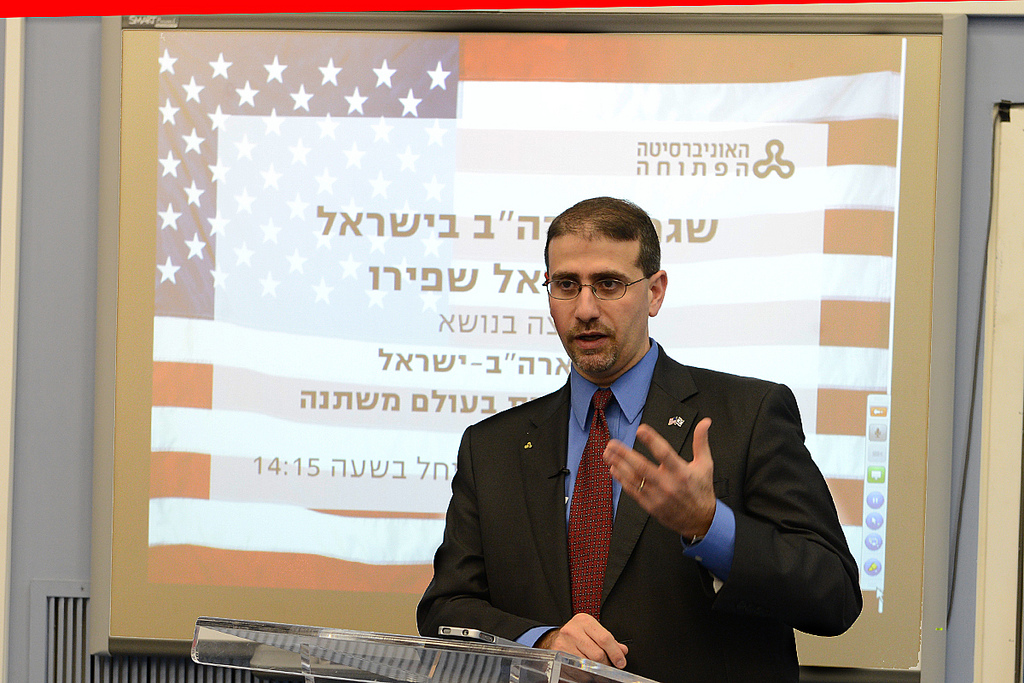by Robert Olson
“The fading two-state solution.”
This was the caption of the lead editorial of The New York Times on Jan. 23, emphasizing there was no or little chance of any two-state solution in which a Palestinian state would come into existence in the West Bank. To be sure, such a state, even if had a chance to materialize, would be a truncated entity, consisting at most of some 40 percent of the 2,200-square-mile West Bank . Implicitly unmentioned in the Times editorial was the fact that even if such a truncated entity were to be created, it would not include Area C of the 1993 Oslo Accords, which comprises 60 percent of the West Bank.
Most scholars and analysts of the Israeli-Palestinian conflict determined at least three or four years ago there would be no two-state solution to the conflict. The reasons are clear: No US administration would ever demand that any of the 250,000 Jewish settlers be removed from the 10 percent of the West Bank ensconced between the 1967 cease-fire line and the barrier wall. It is also highly unlikely that any of the 400,000 Jews in the West Bank settlements will be removed. This would mean that only 80,000 to 90,000 Jewish settlers in “outposts” would be removed in any two-state solution.
This was clear when the nine-month negotiations that US Secretary of State John Kerry conducted with Israeli Prime Minister Benyamin Netanyahu ended in failure in April 2014. Despite the fact that Israel broke off the talks, both Kerry and US President Barack Obama kept on saying, at least publicly, that they thought a two-state solution was in Israel’s interest.
On Dec. 6, 2015, speaking at the Brookings Institution in Washington, D.C., Kerry stated: “It would cost Israel billions of dollars to control the West Bank, while they would run the risk of allowing religious extremism to fill the vacuum of chaos, lawlessness and desperation. Israel would also shoulder the responsibility of providing basic services in the West Bank, including schools, hospitals and law and order.”
One State Solution not in Israel’s Interest
Kerry and Obama kept repeating again and again that it was not in Israel’s interest “as a Jewish state” to have a “one-state” solution: “The one-state solution is no solution at all for a secure, Jewish, democratic Israel living in peace.” At a think tank in Tel Aviv on Jan. 18, US Ambassador to Israel Daniel Shapiro again launched a strong attack on Netanyahu’s right-wing government, stressing once again that Israel’s remaining a democratic, Jewish state depended on a two-state solution. Shapiro himself is Jewish and an ardent supporter of Israel. But the two-state solution, Shapiro said, is “Israel’s only path to avoid becoming a bi-national state. We [meaning the US and Israel] must find ways of preserving the viability of the two-state solution for the future.”
A spokesperson for the Netanyahu government made clear the distain that he and the government held for Shapiro. “To put it bluntly,” said Aviv Bushinsky, “it was a statement of a typical ‘little Jewish boy’,” using the derogatory Yiddish term “yehudoni” to describe Shapiro. This of course caused an immediate media firestorm of responses on the part of Washington and Tel Aviv. It demonstrated the increasing differences between not just the ruling Likud-led coalition government but most all of Israel’s political parties; almost all oppose a two-state solution or even a one-state solution. This includes Isaac Herzog, the leader of the Zionist Camp and the major challenger to Netanyahu’s Likud-led coalition.
Has the US administration had it all wrong for the past 15 years? This period includes both the George W. Bush and Barack Obama administrations, i.e., that Israel wants or would accept a two or a one-state solution. Have US administrations for the past for the past 10 to 20 years had it wrong by stressing the need for a two-state solution in order to protect the viability of Israel as a Jewish and democratic state, one which would have the approval of the American Jewish community and, hence, of Congress?
Israel’s policy for the past decade or more is clear. It will continue to expand settlements throughout the West Bank. It will built and exclude Palestinians from Area C. On Jan. 21, in one of its latest confiscations Israel announced that it would annex 350 acres of “state land” near Jericho (Ariha) in the West Bank’s Jordan Valley. In November, Minister of Education and Diaspora Affairs Naftali Bennett said Israel would begin to settle 100,000 Jews in the Golan Heights conquered by Israel from Syria in 1967, further encircling Palestinians in the West Bank. There is nothing that Syria can do because it is in the throes of a profound civil war.
Bennett has also stated there is no need for either a two-state or a one-state solution. According to Bennett, the Palestinians in pre-1967 Israel are under control and the 320,000 Palestinians in East Jerusalem are being integrated into Greater Jerusalem. As for the 2.5 million Palestinians in the remaining 40 percent of the West Bank, they will not be allowed to vote or become citizens of Israel, lessening the possibility that Israel will lose its “Jewish state” identity and characteristics — the fear of past US administrations, the Obama administration and a goodly proportion of Americans.
Managing Palestinian Challenges
It is also quite possible that the non-citizen, non-voting Palestinians in Areas A and B of the West Bank, with increasingly fewer opportunities to make a living, will elect to immigrate to some other country in the coming years, reducing further the need or obligation to manage them. It is Israel’s and Jewish Israelis’ optimism that their strong economy and securitized state, the weak Palestinian government and fractionalized nationalism and the collapsed Arab nationalism and order will enable them to manage any Palestinian challenges in the future.
And, as far as Shapiro is concerned, in the eyes of many Israeli nationalists he is probably “a little Jewish boy.” It is Israel’s “big boys” who are now calling the shots, and not any longer just in Israel but in other regions of the Middle East. It is clear that Washington is no longer calling the shots with regard to Israel’s future and the disposition of the West Bank.
Israel’s task has been made much easier by the close relations it has fostered with Arab Sunni states of the Persian Gulf as well as with Jordan and Egypt and even with Iraq’s Kurdistan Regional Government (KRG). This is also true of Turkey as it seeks to reset its relations with Israel. Part of this resetting of Ankara’s new assessment of relations is the realization that Israel is becoming its most important potential ally in the eastern Mediterranean — certainly much more important than Turkey’s relations with the Palestinian Authority or with Hamas-run Gaza.
The Obama administration’s relations with Israel have cooled a bit since Israel, Netanyahu and pro-Israel and Jewish lobbyists, with a good deal of help from the US Congress, tried to sabotage the P5+1 nuclear agreement with Iran in July 2015. Despite Netanyahu’s personal humiliation of Obama, pro-Israel sentiments are still high among members of Congress and the American public. Even before the July 14 agreement was signed, Israeli military and security representatives were in Washington asking for substantial additions to US aid. The current U.S. foreign aid to Israel is $3.3 billion annually, but total aid to Israel probably is around $5 billion. Israel wants to raise the foreign aid itself to $5 billion. The current agreement runs out in 2017. Israel is asking that the total aid during the period 2017 to 2027 should be in the range of $50 billion, or about $5 billion a year. This amount should also contribute significantly to Israel’s ability to complete its annexation of the West Bank.
Israel is already a wealthy country, with an average per capita income of around $32,000, as compared to about $2,000 in the West Bank. Since 20 percent of Israel’s population is Palestinian, who have much lower incomes than Israeli Jews, the Jewish Israeli per capita income could be well above $35,000.
In addition, in 2015 Israel’s income from cyber war exports was between $3 to $4 billion, second only to that of the US. Much of Israel’s cyber war capabilities are also a result of its collaboration with Silicon Valley. There is no doubt that this collaboration will continue. Israel also produces the wings for the F-35 fighter jet under a $5 billion contract with Lockheed Martin. It is rumored that upon sale, Israel will receive a substantially lower price than the current estimated selling price of $100 million. Israel also produces some avionics and electronics used in the F-35.
In short, there is good reason for the Persian Gulf Arab Sunni states as well as Turkey to foster close relations with Israel. The destruction of Iraq and Syria as viable states makes such collaboration even more imperative. Indeed, such collaboration now seems to be occurring on a regular basis.
This means there is now no need for a two-state solution.
Photo: U.S. Ambassador Daniel Shapiro
This article reprinted, with permission, from Today’s Zaman.






The two-state solution is not “fading,” it’s long dead, and it’s rotting corpse should be given a decent burial. And when this is finally done, Palestinians should begin demanding the vote – unless, of course, they’ve developed a taste for being constantly humiliated by the bully who’s running this slow-motion genocide.
Overall, a sound outline of the current situation. However, I can suggest one glaring omission. The Fourth Geneva Convention, framed in 1948, as an international response to the various aggressions, seizures of land, ethnic cleansings, and outright genocides of World War II. Israel signed (or and/or ratified) Fourth Geneva (it has since learned not to sign human rights or war crimes statutes); however, under developing international law Fourth Geneva, being accepted international law, would apply to Israel’s actions on the West Bank, even if Israel had actually not agreed to Fourth Geneva.
Supporters of Israel propose arguments claiming that Fourth Geneva does not apply to the “Occupied Territories” due to the tangled history of the area, arguments that seem to suggest that these areas really never believed to anyone, or something of that sort. I have never really found any experts, other than many Israelis and some convinced supporters of a Greater Israel, that accept these arguments. (I am reminded of the arguments that surfaced after Israel captured the Sinai, claiming that it might as well belong to Israel, as it had never really been part of another state, ignoring about 6000 years of Egyptian occupation.)
Grasping the stipulations of Fourth Geneva, and having followed the history of Israel’s behavior in and settlement of the West Bank, for example, it is hard to identify any part of Israel’s actions there that is not in clear violation of Fourth Geneva. Israel’s (unstated) position seems to be that continued occupation of the land, and endless violation of international law that was written to govern the behavior of occupying powers towards populations presumably temporarily ruled, eventually leads toward annexation of occupied lands, transfer of land parcels and resources, and the translation of the population into an untermensch eternally without rights.
To date 138 recognized states have recognized Palestine as a state, and finally several western European states have joined or will soon join this majority. This will clearly lead to additional diplomatic conflict.
Israel thinks it can determine how much of the West Bank it annexes, without any input from Palestine. This assumption may be proven incorrect.
The two-state solution was never anything but a rubber-stamp of Israeli racism and colonialism. It’s all Palestine.
A one state solution is not only feasible but desirable. No one in Israel wants another terrorist, racist Arab country. The Palestinian Arabs have shown themselves to be an irresponsible, antisemitic people. After Israel annexes the West Bank they will eventually offer citizenship to the Arabs. We don’t need another country that is gay-hating, women-abusive and antisemitic. If gay-hating, women-abusive and antisemitic Palestinians got a country, it would be a win for another repressive state.